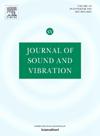Overcoming stretching and shortening assumptions in Euler–Bernoulli theory using nonlinear Hencky’s beam models: Applicable to partly-shortened and partly-stretched beams
IF 4.3
2区 工程技术
Q1 ACOUSTICS
引用次数: 0
Abstract
This paper addresses the challenges of the Euler–Bernoulli beam theory regarding shortening and stretching assumptions. Certain boundary conditions, such as a cantilever with a horizontal spring attached to its end, result in beams that partly shorten or stretch, depending on the spring stiffness. The traditional Euler–Bernoulli beam model may not accurately capture the geometrical nonlinearity in these cases. To address this, nonlinear Hencky’s beam models are proposed to describe such conditions. The validity of these models is assessed against the nonlinear Euler–Bernoulli model using the Galerkin method, with examples including cantilever and clamped–clamped configurations representing shortened and stretched beams. An analysis of a cantilever with a horizontal spring, where stiffness varies, using the nonlinear Hencky’s model, indicates that increasing horizontal stiffness stiffens the system. This analysis reveals a transition from softening to linear behavior to hardening near the second resonance frequency, suggesting a bifurcation point. Despite the computational demands of nonlinear Hencky’s models, this study highlights their effectiveness in overcoming the inherent assumptions of stretching and shortening in Euler–Bernoulli beam theory. These models enable a comprehensive nonlinear analysis of partly shortened or stretched beams.
利用非线性 Hencky 梁模型克服欧拉-伯努利理论中的拉伸和缩短假设:适用于部分缩短和部分拉伸梁
本文探讨了欧拉-伯努利梁理论在缩短和拉伸假设方面所面临的挑战。某些边界条件(如悬臂的端部连接有水平弹簧)会导致梁根据弹簧刚度发生部分缩短或拉伸。传统的欧拉-伯努利梁模型可能无法准确捕捉这些情况下的几何非线性。为此,我们提出了非线性 Hencky 梁模型来描述这种情况。使用 Galerkin 方法,以悬臂和夹紧-夹紧配置(代表缩短和拉伸梁)为例,对照非线性 Euler-Bernoulli 模型,评估了这些模型的有效性。使用非线性 Hencky 模型对带有水平弹簧的悬臂进行了分析,结果表明,水平刚度的增加会使系统变得更加坚硬。该分析表明,从软化到线性行为的过渡到第二共振频率附近的硬化,表明存在分叉点。尽管非线性 Hencky 模型的计算要求很高,但本研究强调了它们在克服欧拉-伯努利梁理论中固有的拉伸和缩短假设方面的有效性。这些模型能够对部分缩短或拉伸的梁进行全面的非线性分析。
本文章由计算机程序翻译,如有差异,请以英文原文为准。
求助全文
约1分钟内获得全文
求助全文
来源期刊

Journal of Sound and Vibration
工程技术-工程:机械
CiteScore
9.10
自引率
10.60%
发文量
551
审稿时长
69 days
期刊介绍:
The Journal of Sound and Vibration (JSV) is an independent journal devoted to the prompt publication of original papers, both theoretical and experimental, that provide new information on any aspect of sound or vibration. There is an emphasis on fundamental work that has potential for practical application.
JSV was founded and operates on the premise that the subject of sound and vibration requires a journal that publishes papers of a high technical standard across the various subdisciplines, thus facilitating awareness of techniques and discoveries in one area that may be applicable in others.
 求助内容:
求助内容: 应助结果提醒方式:
应助结果提醒方式:


